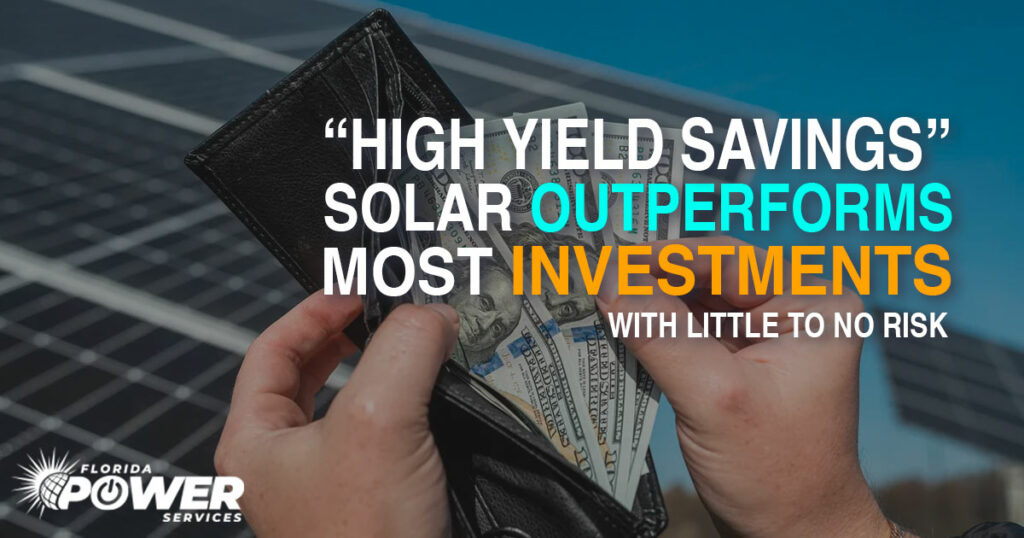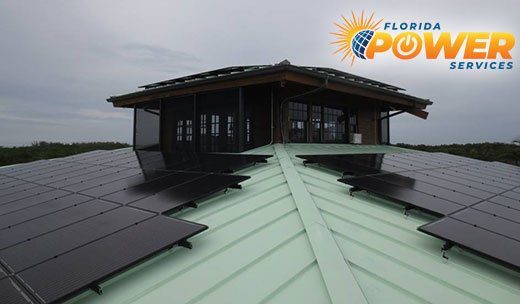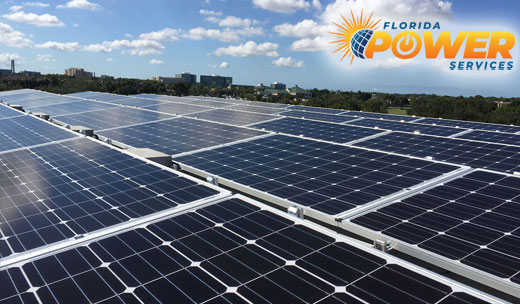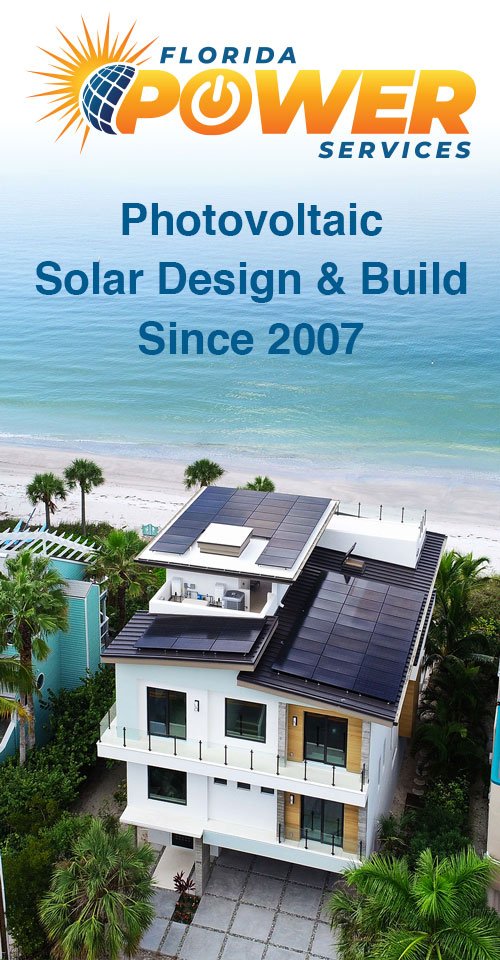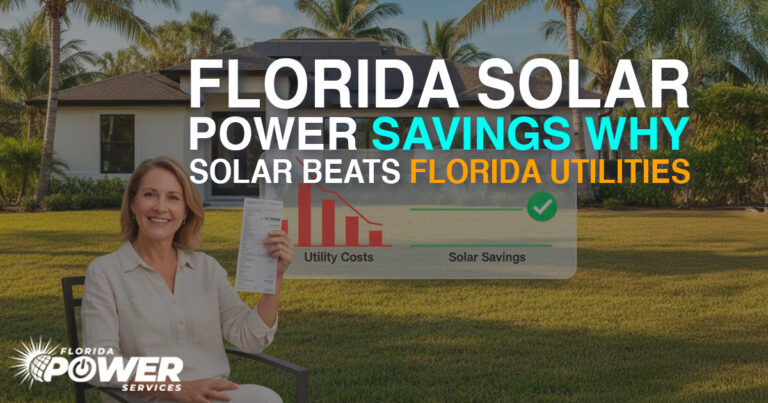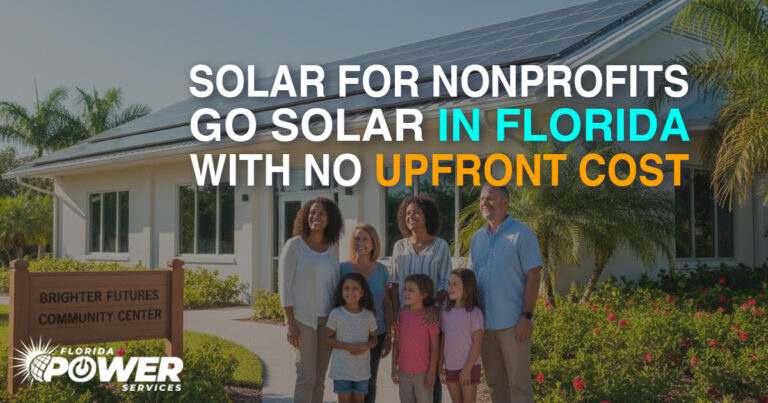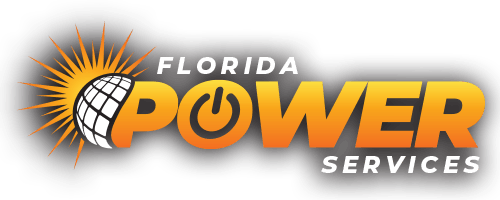When it comes to smart investment choices, solar power shines bright with potential. Recognized for its sustainable and profitable nature, it’s no surprise that savvy investors are turning their attention to solar energy. And where better to capitalize on this radiant opportunity than in Florida—the Sunshine State itself?
Here are some key reasons why solar power is a viable investment in today’s economy:
1. Low Risk, Tangible Investment: Unlike riskier investment assets such as stocks and crypto currencies, solar power is a tangible investment with an impact that you will be able to see immediately. Furthermore, solar production is warrantied for 25 years and is based on 30 years of weather data. Unlike other popular investment tools, solar energy will not be significantly affected by the business cycle or changes within the political landscape.
2. Financially Sound Choice: Solar power is not only beneficial for the planet but also a smart financial move. The cost of solar panels has been consistently dropping over the past decade, making it more affordable for homeowners and businesses. Along with lower expenses, there are various financing options available that make solar power an attractive investment opportunity. Consider the fact that over the past 4 years utility rates have skyrocketed over 30%, and imagine being able to put your money in a high yield savings account with a 30% APR!
3. Multiple Benefits: Going solar offers more than just savings on electricity bills. It can also:
- Increase property value: Solar installations are seen as desirable features in homes and commercial buildings, leading to higher property prices.
- Provide energy independence: By generating your own electricity, you become less reliant on traditional energy sources and utility companies.
- Generate passive income: Through net metering programs, excess energy produced by your solar panels can be sold back to the grid, earning you credits or payments.
The Case for Solar Power as a Superior Investment
When we think of solar power investment, it’s natural to first consider its environmental benefits. Yet, there’s more to this story! Delving deeper, it becomes clear that solar power holds its own as a viable financial choice, presenting unique advantages that set it apart from traditional investments like high yield savings accounts. So, what makes solar power shine in the financial landscape? Let’s shed some light on this:Financial Benefits of Solar Power
- Energy Savings: By generating your own electricity, you can significantly reduce or even eliminate your utility bills. For example, in sunny states like Florida with an average of 237 sunny days per year, the savings can be substantial.
- Government Incentives: The Federal Solar Tax Credit offers a whopping 30% tax credit on your total solar system costs. Combining this with the domestic content adder (which our installations qualify for) and you are looking at a total of 40% in tax credits. This hefty incentive makes the initial investment in solar power more affordable. Plus, don’t forget about state-level incentives! Florida offers sales and property tax exemptions for those who install solar systems.
- Net Metering: A hidden gem in the world of solar power is the ability to sell excess energy back to the grid. In Florida, homeowners with solar panels are allowed to do just this – turning your home into a mini power station that actually earns money!
The Limitations of High Yield Savings Accounts
Investing in a high yield savings account might seem like a safe bet when it comes to wealth accumulation. However, it’s important not to overlook the inherent limitations and risks associated with this type of investment strategy. One of the major drawbacks of high yield savings accounts is their limited growth potential. While these accounts offer competitive interest rates compared to regular savings accounts, they still fall short when it comes to long-term wealth growth.Factors that limit growth potential
Here are some factors that contribute to the limited growth potential of high yield savings accounts:- Inflation rates: A crucial factor to consider is inflation. With the average annual inflation rate hovering around 2%, even a high yield savings account offering an annual percentage yield (APY) of 1% can result in a net loss of purchasing power over time. This means that your money isn’t growing as fast as the cost of goods and services, essentially eroding your wealth in real terms.
- Limited withdrawals: High yield savings accounts also have restrictions on how often you can withdraw funds. Under federal law, you’re typically limited to six withdrawals or transfers per statement cycle. Exceeding this limit may lead to fees or account closure.
- Variable interest rates: Another factor to consider is that the interest rates on these accounts are variable and can change based on market conditions. This can introduce an element of uncertainty into your investment.
Analyzing the Financial Performance: Solar Power vs. High Yield Savings Account
To effectively compare the financial performance of solar power investments and high yield savings accounts, it’s important to consider a range of factors. These include initial costs, ongoing expenses, potential returns, tax incentives and risk levels. Let’s take a look at a hypothetical case study: A homeowner in sunny Florida decides to install a 5kW solar panel system on their property. The total cost for this installation is $15,000. However, with the Federal Solar Tax Credit of 30%, the net cost comes down to $10,500. On the other hand, if that same homeowner decides to put $10,500 into a high yield savings account with an annual percentage yield (APY) of 2%, after 25 years (the average lifespan of a solar panel), they would have approximately $17,800.Solar Power Investment Analysis
Here are the details of the solar power investment:- With an average of 237 sunny days per year in Florida, our homeowner can expect substantial energy savings each year.
- Let’s assume they save around $100 on their monthly electricity bill. That’s $1,200 saved annually.
- Over 25 years, that equates to $30,000 in utility bill savings alone.
- Florida homeowners can sell excess energy back to the grid through net metering. Let’s add another $5,000 over those 25 years.
- Our homeowner has now made a stunning $35,000 from their initial $10,500 investment.
Solar Cashflow Chart
In the above example we did not discount the fact that utility rates have been on a steep climb in recent years, increasing to over 30% in the last 4 years alone. For a more accurate look at the ROI of investing in solar consider this example using an initial $45,000 investment in solar. Example: A $45,000 investment in solar; $45,000 Out Of Pocket -$18,000 Fed Tax Credit (30% + 10% Adder) $27,000 Net Cost| Year | Net Cost | Annual Savings | Rising Cost of Power | ROI |
| 0 |
-$27,000 |
$4,500 |
5% | 635% |
| 1 |
-$22,275 |
$4,725 |
||
| 2 |
-$17,314 |
$4,961 |
||
| 3 |
-$12,104 |
$5,209 |
||
| 4 |
-$6,635 |
$5,470 |
||
| 5 |
-$891 |
$5,743 |
||
| 6 |
$5,139 |
$6,030 |
||
| 7 |
$11,471 |
$6,332 |
||
| 8 |
$18,120 |
$6,649 |
||
| 9 |
$25,101 |
$6,981 |
||
| 10 |
$32,431 |
$7,330 |
||
| 11 |
$40,127 |
$7,697 |
||
| 12 |
$48,208 |
$8,081 |
||
| 13 |
$56,694 |
$8,485 |
||
| 14 |
$65,604 |
$8,910 |
||
| 15 |
$74,959 |
$9,355 |
||
| 16 |
$84,782 |
$9,823 |
||
| 17 |
$95,096 |
$10,314 |
||
| 18 |
$105,926 |
$10,830 |
||
| 19 |
$117,297 |
$11,371 |
||
| 20 |
$129,237 |
$11,940 |
||
| 21 |
$141,773 |
$12,537 |
||
| 22 |
$154,937 |
$13,164 |
||
| 23 |
$168,759 |
$13,822 |
||
| 24 |
$183,272 |
$14,513 |
||
| 25 |
$198,511 |
$15,239 |

